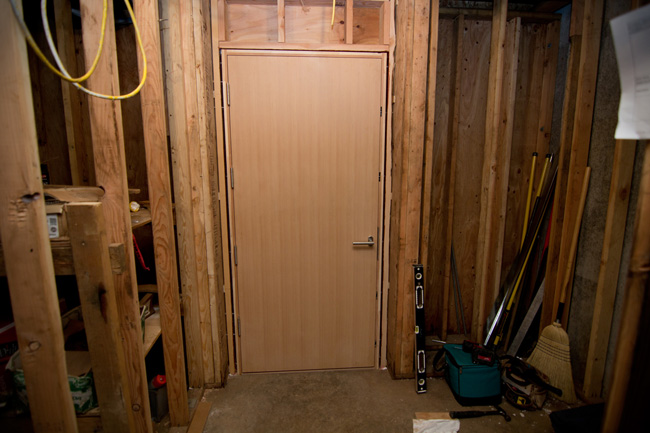New door at Karuna matches European-made rivals at lower cost, both in dollars and carbon.
The new high performance Passive House door (learn more about our custom high performance doors here) built for the Karuna House by Hammer & Hand’s Dan Palmer and Josh Tinker marks two milestones reached, one for H&H, the other for Passive House.
Milestone One: superefficient millwork built in-house
The Karuna door shows that the woodshop can build the highest performing custom millwork out there. Our shop has evolved. We still do reproductions of traditional trim profiles and jointery, but we’re also combining our woodworking chops with a new grounding in building science to build doors and windows that can match the performance of the best coming out of Europe. The door at Karuna manifests this development.
Milestone Two: Another step toward making Passive House native to the US
One of the most exciting developments in the US Passive House movement is that the standard is becoming native to the US. While high performance building owes a great debt of gratitude to European pioneers like Dr. Wolfgang Feist of the Passivhaus Institut in Germany, standards like Passive House need to be aligned with the US market, US rating schemes, and US incentive programs to really take off here. Lots of progress has been made by Passive House Institute US and Passive House Alliance US in this regard lately (see PHIUS+).
We need to see similar progress in the supply chains for Passive House materials and components. As long as the highest performing building components are built in Europe, the ongoing energy savings that they confer on US projects may very well outweigh the carbon emissions impact of shipping those components across the Atlantic. (See Brute Force Collaborative’s post on the subject, “Can European windows actually save carbon?”) But ultimately there’s no reason we can’t manufacture those components domestically. And when we do, we’ll start avoiding the financial and environmental costs that come with trans-Atlantic shipping. Homegrown high performance doors like the one at Karuna represent one step toward “components independence” for the US Passive House industry.
The Details
The Karuna House seeks Passive House, Minergie-P-ECO and LEED for Homes Platinum certification, so our task was to build a high performance exterior door made of sustainable materials. (All other exterior doors and windows on the project are manufactured by Optiwin in Austria.)

Core of door constructed with slots to accept poly-iso insulation. (photography in this post by Dan Palmer & Jeff Tan)
Hammer & Hand woodshop manger Dan Palmer and woodworker Josh Tinker built the door from 100% Forest Stewardship Council®-certified wood, with all lamination done in-house.

Various stages of lamination involved traditional clamping (l) and vacuum bag clamping (r) for ultra-even pressure.
Superinsulation, high performance weather stripping, and advanced hardware enable the door to reach the thermal performance required by Passive House. Two 1-inch layers of poly-iso form the insulative core of the door. (The poly-iso can be replaced with vacuum-insulated panels, or VIPs, for even higher thermal performance.) A tiered profile for door and jamb accommodates two in-kerf weather stripping assemblies. An advanced multipoint lock system uses rollers that allow precise tuning of the door’s weather seal.

The tiered profile for door and jamb.

Two levels of in-kerf weather stripping provide a tight weather seal.

The multipoint lock system.

The finished door at the shop (l), and being installed by Dan (r).
The door’s heft and thickness are reminiscent of European high performance doors, but Dan designed the Karuna door to use standard North American butt hinges. This detail matches the look of the other doors at Karuna and makes installation more practical – the fit and finish are standard, easy for installers to work with.

The door has significant heft (l), uses North American butt hinges (r).
In related news, Dan and Josh just finished installation of retrofitted windows on an historic Portland home today, transforming them into highly efficient units while preserving their architectural heritage. So please stay tuned for more high performance millwork stories soon!
– Zack

The high performance Passive House door, installed at Karuna.